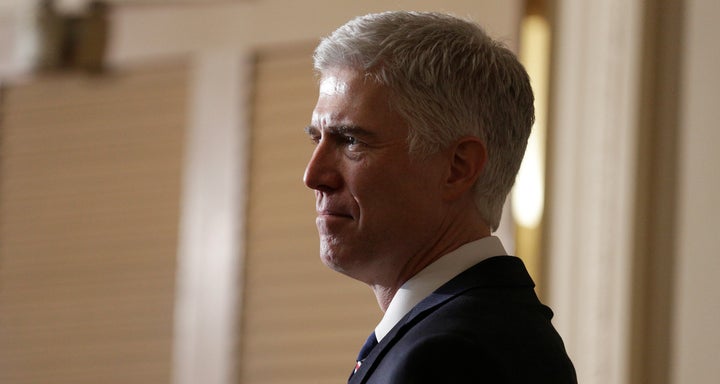
With the nomination of Judge Neil Gorsuch to serve on the Supreme Court of the United States instead of Chief Judge Merrick Garland, and with the possibility of another Trump Supreme Court nomination at some point down the road, it is useful to reflect on the history of homosexuality in Western culture and on the pivotal role the Supreme Court has played in helping to shape our nation’s laws in this regard. The plain and simple fact is that, with two Trump appointments to the Supreme Court, should that come to pass, we can expect significant changes in the way the Court approaches the rights of gays and lesbians in the future.
Before we get to that point, it is important to understand how we got to where we are today. It is only with that understanding that we can truly comprehend the magnitude of the challenge ahead. In my last piece, I briefly explored the history of homosexuality from the ancient world through the 1950s.
In this post, the second of three on this subject, I will trace the history of homosexuality in the United States from the 1960s to the 1990s. Each of these posts, I should note, is drawn in part from my forthcoming book, Sex and the Constitution. I hope you will find this history instructive.
As set out in my prior post, by the late 1950s gays and lesbians in the United States had been driven deep into the closet by social and religious forces that were inflexibly intolerant of their very existence. A decade later, though, a handful of courageous gay men and lesbians, inspired by the civil rights and women’s rights movements, began calling openly for the acceptance of homosexuals “as full equals” in society.
In 1969, for example, Carl Wittman, a gay SDS leader, penned what he termed The Gay Manifesto, in which he declared: “Our first job is to clear our own heads of the garbage that’s been poured into them. ... Liberation for gay people is defining for ourselves who we are. It is time for us to come out.”
This was the first time anyone had used the term “come out” in this manner. For those who sought equal treatment for gays and lesbians, “coming out” was a radical and daring act that would affect every aspect of their lives. Indeed, as late as 1969, only a few hundred members of the growing gay rights organizations in the United States had dared publicly to identify themselves as homosexuals. This was about to change.
At around 1:00 a.m. on the night of Friday, June 27, 1969, the New York police raided the Stonewall Inn, a dingy, Mafia-owned gay bar on Christopher Street in Greenwich Village. Five other New York bars had been raided in the previous three weeks, resulting in many arrests, but this time the drag queens, bar boys, and lesbians who had either been in the bar or in the gathering crowd outside resisted the police. As one historian described the scene, the police “took on men in wigs in a bar and all hell broke loose.”
The next night, hundreds of gay men and women gathered on Christopher Street, leading to yet another confrontation with the police, an event that generated national attention. A month later, Martha Shelly, a lesbian firebrand, and other gay and lesbian activists formed the Gay Liberation Front. As Shelly explained, “We didn’t want to be accepted into America the way it was. We wanted America to change.” A year later, thousands of people commemorated the anniversary of Stonewall by marching in New York City, Chicago and Los Angeles in the nation’s first Gay Pride parades.
The decade after Stonewall saw gradual, but halting, progress in the cause of gay rights. In 1972, a lesbian was allowed to retain custody of her children in a contested divorce for the first time in American history. In 1973, the American Psychiatric Association declared for the first time that homosexuality was not a mental illness. And by the end of the decade, 22states had repealed their laws making consensual sodomy a crime.
These developments sparked a sharp backlash, however. The most dramatic explosion arose over a proposed gay rights ordinance in Dade County, Florida. In 1977, the county commission, following the lead of several other cities, passed an ordinance prohibiting employment discrimination on the basis of sexual orientation. Local religious groups were outraged, and demanded an immediate repeal of the ordinance.
Anita Bryant, a born-again Baptist and nationally known entertainer and form Miss America beauty queen, led the campaign. Local Baptists charged that the law violated God’s biblical commandments, Bryant fumed that gays were “trying to recruit our children to homosexuality,” and the National Association of Evangelicals soon entered the fray. Leaders of the Christian Right, including Jerry Falwell, Pat Robertson, and Jim and Tammy Baker, came to Miami to campaign in favor of repeal, and in a special referendum, Dade County’s voters repealed the ordinance.
This victory generated momentum for a new, even more deeply religion-based anti-gay movement. The campaign took on an ugly tone as bumper stickers appeared across the nation with such messages as “Kill a Queer for Christ.” Within two years, many of the laws that had been enacted in other cities to protect gays from discrimination were also repealed.
The Christian Right charged that such laws promoted “child molesting” and “gay recruiting,” and the Rev. Jerry Falwell raged that “Homosexuals do not reproduce! They recruit! And, many of them are after your children.” The anti-gay rights crusade saw this fight as a religious battle for the Christian soul of America.
Soon thereafter AIDS struck the gay community with a vengeance. As the disease became associated in the public mind with homosexuality, the Christian Right deemed AIDS God’s punishment for homosexual sodomy. As the Rev. Jerry Falwell declared, “AIDS is not just God’s punishment for homosexuals. It is God’s punishment for the society that tolerates homosexuals.”
The Reagan administration, which had actively courted the Christian Right, had no interest in devoting “government time or money” to an illness that was thought to threaten only gay men. Rather than invest federal funds in medical research, the White House instructed the Center for Disease Control to “look pretty and do as little as we can.”
Over the course of the next decade, AIDS ravaged the homosexual community, killing more than a quarter-of-a-million gay men and leaving hundreds of thousands more to wonder if they might be next.
Ironically, though, the horror of AIDS brought homosexuality into the light. As thousands of gay men died horrible deaths, people had to take notice – often, though not always, with sympathy and concern. Gradually, one person at a time, in often awkward and sometimes excruciatingly painful conversations with family, friends, and acquaintances, the previously closeted lives of homosexuals became visible, first out of necessity and desperation, then later out of candor and self-respect.
“Gay invisibility” was suddenly melting away. As if in a dream, gays and lesbians suddenly saw newspaper articles affirming their social identity. In 1993, Tony Kushner’s play Angels in America won the Tony Award, and the following year the movie Philadelphia, which addressed the AIDS epidemic, because the top-grossing film in the nation. At the Gay and Lesbian March on Washington in 1993, hundreds of thousands of individuals wearing pink triangles marched proudly past the White House in support of equality.
Four years later, Ellen DeGeneres, star of the popular ABC television show Ellen, came out as a lesbian. Shortly thereafter, some 42 million viewers tuned in to watch DeGeneres’ character, Ellen Morgan, reveal that she, too, was a lesbian.
Not everyone cheered. The response of the Christian Right was fierce. The Rev. Jerry Falwell called Ellen DeGeneres “Ellen DeGenerate,” and the Southern Baptist Convention called for a boycott of ABC because it had broadcast the show.
In the view of the Christian Right, homosexual perversion, immorality, and degeneracy were being spewed across the land. Donald Wildmon, the president of the American Family Association, railed that homosexuality was “a sin grievous to God and repulsive to Christians.” This struggle, he declared, was a matter of life and death, because if we fail, “we fear the judgment of God on our nation.” The battle lines had clearly been drawn.
And the battle soon turned to the Supreme Court. ...
